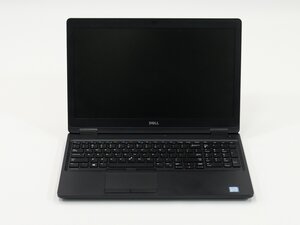crwdns2862678:0crwdne2862678:0
crwdns2895503:0crwdne2895503:0
If nothing happens ( no power light, fan noise, or keyboard or mouse response) when you press the power button on your Dell Latitude 5580 laptop, this guide offers potential solutions.
Damaged Power Supply
A faulty AC adapter can prevent power from reaching the laptop. If the adapter is damaged, the system will not power on, and you may see no LED activity.
- Look over the cable for damage, loose connectors, or bent prongs.
- Test the AC adapter with a different Dell laptop or try a known-working adapter.
- If the adapter fails or the LED light turns off when plugged into the laptop, the adapter may be faulty, or the system board may be shorted.
- If confirmed faulty, replace the adapter. A battery provides power for operating your Dell 5580 laptop, which uses lithium-ion batteries. Power issues on Dell 5580 laptops are compounded because a computer has two power sources: an AC adapter (charger) and a battery. The battery provides power to the laptop when the AC adapter is not connected to the Dell 5580.
- If the adapter works elsewhere, the issue may lie with the laptop itself (e.g., DC jack or motherboard).
Software Glitch
Sometimes your laptop will glitch and just needs a hard reset to correct the error.
- This can resolve issues caused by static build-up or minor BIOS problems.
- Unplug the AC adapter.
- Remove the battery (if it's removable).
- Press and hold the power button for 30 seconds.
- Reconnect only the AC adapter (not the battery).
- Try turning the laptop on.
Battery Failure
Battery-related issues can prevent the Dell Latitude 5580 from powering on, especially if the battery is dead, malfunctioning, or not recognized by the system. You'll know if your battery is the issue if you're experiencing the "plugged in, not charging" when hovering over the battery icon, the battery charge is stuck at a fixed percentage or doesn't hold a charge, or the battery LED does not light up or blink during charging.
- Test the battery:
- Remove the battery and power the laptop using only the AC adapter.
- If the laptop powers on, the battery is likely the issue.
- Check the battery connection:
- Please ensure the battery is securely seated and locked in place (if removable).
- Try a known-good charger:
- Incompatible or underpowered chargers can prevent battery charging.
- Dell 5580 supports both barrel and USB-C charging; try both if available.
- Replace the battery if faulty:
** If the battery is dead or not functioning and troubleshooting doesn't solve the issue, it may be time to replace the battery. You can do so by following this guide.
Overheating
If the Latitude 5580 becomes too hot, it may shut down and refuse to boot until cooled. Excessive heat can also cause long-term hardware damage. This may look like random shutdowns or reboots, it's warm or hot to the touch, the system is unresponsive after prolonged use, or the fans run at full speed before power-off.
- Allow the system to cool:
- Power off and wait at least 30 minutes in a cool, ventilated area.
- Improve airflow:
- Place the laptop on a hard, flat surface.
- Clean air vents using compressed air.
- Update BIOS:
- Dell occasionally updates thermal control settings via BIOS updates.
- Monitor temperatures:
- Use software like Open Hardware Monitor to check internal temperatures.
Fan Failure
If your Dell laptop 5580 gets too hot, it will shut down for safety reasons. A failed cooling fan can prevent the Dell laptop 5580 from booting.
- Power on and listen for fan spin-up.
- It may need replacement if the fan doesn't engage or emits unusual noises. You can replace the fan by following this guide.
Outdated or Corrupted BIOS
An outdated or corrupted BIOS can interfere with the startup process or stop the system from turning on.
- To use BIOS recovery mode, Hold Ctrl + Esc, plug in the adapter, and follow on-screen prompts (if supported).
- If recovered, update the BIOS from Dell Support.
Motherboard Failure
A failed motherboard (also called the system board) can stop the system from powering on. You'll know if your device has a failed motherboard if your laptop turns on but the screen remains black, has unusual sounds, or if there is physical damage seen on the motherboard.
- Perform a motherboard self-test: Disconnect power and hold the power button for 30 seconds. Reconnect and try powering on.
- Check for diagnostic codes (beeps or LED blinks).
- Replace the motherboard if all other causes are ruled out and the system still doesn't respond.


crwdns2944067:00crwdne2944067:0